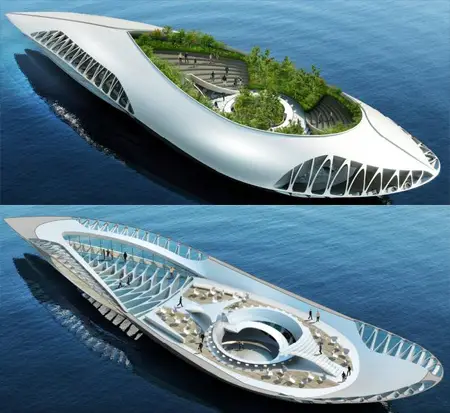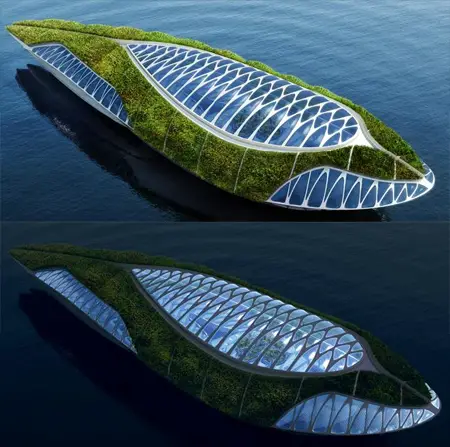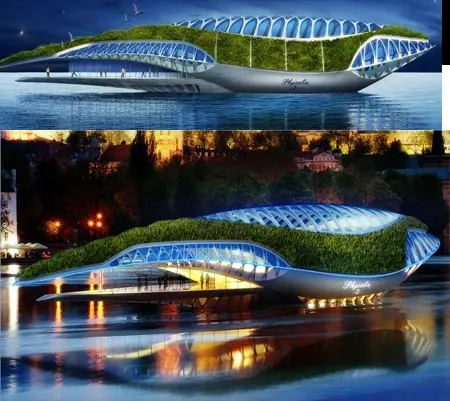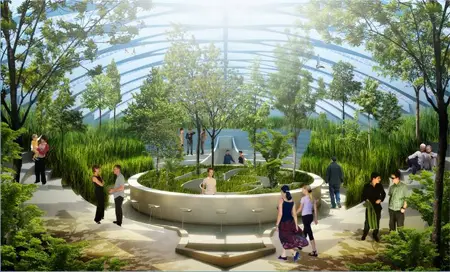Physalia is an innovative scientific architectural vessel prototype that aims to meet the need of new generation floating purification station in order to sensitize the population with sulpher and carbon free ecological tools. This amphibious vessel concept is a half earthly and half aquatic floating agora that not only deals with ecology by saving water, but also elaborates strategic solutions to sentient the fluvial network. With its various functional features, this vessel not only contributes the environment by saving water, refilling ground waters, controlling domestic, industrial and rainwater recycling, purifying agriculture pollutions (nitrates, plant health), desalinating sea water and many more, but also promotes the waterways as fluvial tourism and commercial transport, water sports, agriculture irrigation, hydro-electricity production, protection against floods, and many more.


The bionic structure of this self sufficient vessel in energy is inspired from the pneumatophorous, which means “water bubble” and combines the nature and biotechnologies to navigate on the key extra-European rivers. The eco-designed zero carbon emission architecture is based on renewable energies, which means generating more energy than it consumes. The roof is featured with a double pneumatic membrane with smooth photovoltaic solar cells and the hydro-turbines under the hull transform the energy of the fluvial flow in hydro-electricity. The aluminum surface covers the multi-hull steel structure that reacts to the ultraviolet rays to decrease the water pollution. In fact, Physalia is not only a self cleaning vessel, but also it is able to absorb and recycle the carbon and chemical waste of the fluvial water through photo-catalytic effect.

The Physalia interior is featured with four thematic gardens that symbolize their dedicated typical aspects. The Water garden welcomes the boarders at the entrance placed between the square and the berthing gates. The surface of the area can be opened totally to amalgamate with the fluvial landscape and allow the vessel to breath with the calming fluvial breeze. The center of the concept features the Earth garden, a dedicated laboratory for the international researchers to investigate the aquatic ecosystem. A planted vault is placed on the top of this panoramic room that acts as a fertile metaphor to perform molecular analysis. The Fire garden is an underwater lounge with a huge fire timbale surrounded by soft relaxing armchairs where the passengers can enjoy the golden reflections of the fire. Finally, the Air garden is an ecologic amphitheatre with lots of light and oxygen opened towards the external landscape. A theater stage like circular shaped rotating water bar is the key attraction of this area where the passengers can find the H2O acronym.







Designer : Vincent Callebaut Architectures








Looks awesome. I would love it if this was made. Brilliant design and great ideas. Awesome.
just wonderful!!
This is beautiful, I wish they would really really consider making this, or at least something very similar to it, it's awesome!
Great creative design, but would it hold up in heavy seas? I can see a pretty big roll over issue. Fins perhaps?
Great idea, can't wait to see something like this being built. Good point on the roll over issue. Perhaps some retractable fins, or a roof that would enable you to submerge the entire thing for the duration of a storm? with tidal/wave turbines to take advantage of the waves?
just wonderful. I would love it if this was made. Brilliant design and great ideas. Awesome
wonderful!!!!!!!!!!!
good design but wat r the possibilities of making it into reality